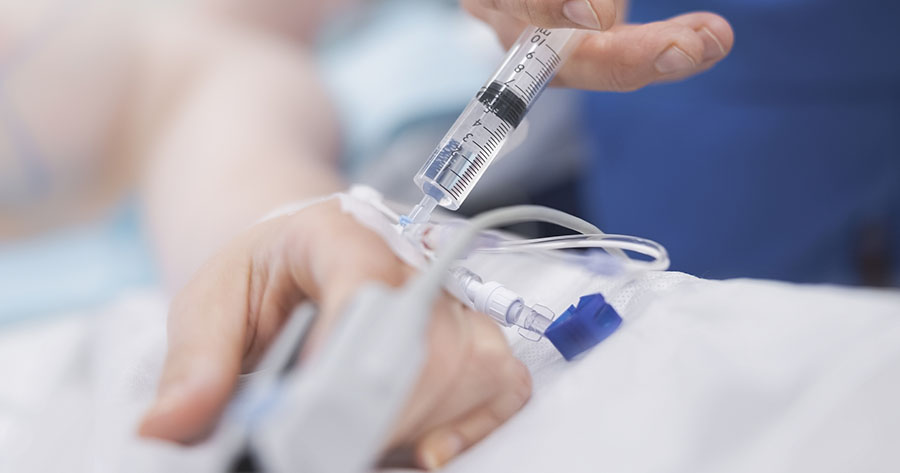Standards 7 and 8 of the National Service Framework for Diabetes (Department of Health, 2001) relate to the management of diabetic emergencies, and the care that people with diabetes receive during admission to hospital. The standards state that people with diabetes should receive effective care of their condition from appropriately trained healthcare professionals, following agreed protocols. The implication is that all individuals should have the opportunity to be seen by a member of the diabetes team, whether they are admitted as a consequence of their diabetes or for any other reason. The National Service Framework also recommends better liaison between the specialist diabetes team and ward staff as a key intervention (Department of Health, 2003).
However, despite the publication of the National Service Framework, a Healthcare Commission survey recently identified that 30% of people with diabetes reported that healthcare staff were unaware of their condition, and 10% received no help with their diabetes at all, while in hospital (Healthcare Commission, 2007). Furthermore, although people with diabetes did get to see specialists about the reason for their admission, the diabetes knowledge of these specialists was varied, and sometimes outdated.
A recent national report demonstrated that these shortfalls in standards of care can result in delayed discharges due to ineffective hyperglycaemia management, cancelled operations, insulin errors and increased morbidity and mortality (National Diabetes Support Team, 2008).
The ideal inpatient diabetes team would be multidisciplinary, including doctors, specialist nurses, dietitians and podiatrists. In reality, however, the pivotal role inevitably falls to the DSN, and there is good evidence to suggest that inpatient care by a DSN translates into a reduced length of inpatient stay (Davies et al, 2001; Sampson et al, 2006).
However, more recent studies (El-Gayar et al, 2007), suggest that at the moment there is an inadequate number of inpatient DSNs to meet this demand, and, in some trusts, one DSN is expected to see all individuals admitted with diabetes.
Any hospital diabetes team is dependent on appropriate and timely referrals to provide a good-quality service. While there are several means available for increasing the chances of a person with diabetes seeing a healthcare professional with expertise in diabetes, such as telephone messages and bleeps, this article describes the development of an electronic referral system that seeks to ensure that every appropriate patient sees an inpatient DSN.
Referral systems
In the authors’ experience, inpatient referrals to the DSN have been received on an ad-hoc basis and in a variety of formats, ranging from telephone messages that simply provide a patient’s name and ward, to bleeps and written referrals (which frequently appear days after the patient has been discharged). This means that the referral information available to the DSN is varied, and invariably requires many return calls to track down either the referrer or the patient’s named nurse. Even then, there may be a number of reasons for the referral, and it can be difficult for DSNs to access the necessary information, and identify exactly what care they are being asked to provide. Dealing with the factors above takes up valuable time, and makes it much harder to organise and manage a caseload.
For any DSN, caseload prioritisation is an essential skill, especially if all the individuals admitted to hospital with diabetes are to be seen by him or her. An ad-hoc type of referral system is unlikely to help a nurse meet this target, especially when approximately 10% of hospital beds will be occupied by a patient with diabetes at any one time (NDST, 2008). Furthermore, an unregulated referral system makes it difficult to maintain records or effectively audit nurses’ workloads. Typical audit questions, such as “How is your time managed?”, “How long did it take you to see a patient following receipt of the referral?”, “How many patients are you seeing?”, and “Which departments are referring most and why?”, can be difficult to answer. Similarly, the amount of time it takes to trawl through diaries and collate the information may further detract from patient care.
The lone DSN
Within the authors’ Trust, at the time of implementation of the referral system, there was only one inpatient DSN, whose remit was to support inpatient diabetes care in all adult specialities. The role also incorporated the education and training of people with diabetes and staff. In order to try to organise this workload, she needed a clear referral pathway that was accessible to all healthcare professionals in the Trust. This pathway needed to be quick and easy to use, as well as providing the DSN with convenient access to patient data.
Developing an electronic referral pathway
The DSN needed access to basic, relevant information regarding each patient in order to be able to prioritise her own workload, and be as responsive as possible to the needs of individual patients and wards. Receiving telephone calls and bleep messages, which were then transferred to a diary, did not provide enough opportunity for her to assess different patients’ needs and priorities. Additionally, it was distracting to be constantly interrupted by bleeps and phone calls.
The DSN felt that establishing a different access system that incorporated more in-depth referral data would reduce interruptions, provide more pertinent data and enable her to prioritise her workload. The obvious solution was to have an electronic referral system, ideally linked to the Clinical Results Reporting System (CRRS), which healthcare staff were already accustomed to using in order to access patients’ clinical information. The Trust’s IT department was approached for assistance in developing a referral pathway that could be used by all wards and departments.
All hospital inpatients are registered on the CRRS, and the majority of healthcare professionals have access to it. By integrating the electronic referral system with the CRRS, it is possible for professionals to refer to the DSN simply by clicking on the request/referral tab (Figure 1). Clicking on this tab takes the referrer to the DSN referral page, where there are a number of mandatory fields to be completed in order for the referral to be submitted (Box 1; Figure 2).
These fields are based on information that the authors identified as being essential to prioritising patients’ needs and being able to respond to the referral appropriately. This includes whether the patient is newly diagnosed, has type 1 or type 2 diabetes, is experiencing episodes of hypoglycaemia or hyperglycaemia, or is in need of education. For example, a person newly diagnosed with type 1 diabetes commenced on insulin will require priority, in terms of DSN time and input, over a person with type 2 diabetes who needs to be shown how to self-monitor blood glucose levels. Information regarding the patient’s current drug regimen is also required, and there is space for the referrer to add extra information if the above options do not adequately cover the reason for the referral, or if they feel there is other information that might be pertinent. Asking for this information also encourages ward staff to think about why they are referring the individual.
The aim is to provide a balance, so that the referrer does not feel that unnecessary details are being requested, and the DSN receives a sufficient amount of detail to enable her to prioritise her caseload.
Also, although the referrer’s name is automatically entered during the log-in procedure, there is a prompt that provides a contact number for the DSN to use if clarification of the referral is required. The referral is also automatically dated and timed.
As the referral is linked to the CRRS, this means that the DSN has access to all the relevant patient details, including, for example, latest blood results, tests and clinical letters. Once the referral is submitted it appears on the DSN’s summary list (Figure 3), and the individual referral details can then be viewed.
The DSN can respond to any referral in a number of ways, for example a telephone call, ward visit, or ward round with the diabetes team, and all responses are recorded on the referral form and submitted to the CRRS in the same way as the original referral (Figure 4). This means that a record of the DSN’s response is accessible to any healthcare professional who needs the information. The DSN can then simply make recommendations electronically via the referral pathway, or arrange to see the patient. The system is set up so that a referral, once it has been actioned by the DSN, is closed, but will remain open if it is it is still pending review.
Of course, the system does not obviate the need for information to be recorded in patients’ medical and nursing notes, and if a ward visit is made by the DSN, any recommendations are still documented on the electronic referral system.
Advantages of the electronic referral pathway
The electronic referral pathway is accessible through a secure server to all healthcare professionals who are registered on the system, and has several advantages. Healthcare professionals can see if and when a referral has been made, and this prevents the duplication of referrals for the same patient. In addition, previous referrals from other admissions can also be viewed. Healthcare professionals can view all the DSN’s recommendations, instructions and care plans and, if required, the page can be printed out and inserted into medical and nursing notes. This is useful if a patient is going home with district nurse support.
Although the pathway has been designed specifically for inpatient care, it can be used in the community as GPs also have access to the CRRS in their surgeries. This facilitates ongoing management, as well as potentially improving communication between primary and secondary care, as GPs do not have to wait for postal information regarding the patient’s diabetes care.
The impact of the system
The implementation of the system has had a positive impact on the DSN’s role. She can assess her workload and prioritise her time much more effectively, and the system helps to determine whether patients need to be seen urgently or whether telephone or CRRS-mediated advice is sufficient. It enables more efficient workload management as the data are auditable and legible, and the system reduces paperwork. The system is also easy to refer back to, can highlight specific areas for education and has cut down the number of telephone referrals and bleep alerts.
For example, if staff from the same ward area are referring individuals repeatedly for advice on hypoglycaemia, a study session can be arranged for them on the causes and appropriate treatment of hypoglycaemia. The authors believe that the benefits of the system are potentially far-reaching, as it could be expanded into other specialities within the Trust; for example, the paediatric DSN has also now implemented the referral pathway.
Implementation
As the referral system designed by the IT department was part of the CRRS, it is very user-friendly, and has a format that is already familiar to most ward-based healthcare professionals. In fact, the DSN was able to begin using it within 5 minutes of receiving an explanation from the IT team.
The system went live in October 2007, and has now become the main route for referrals to the DSN. Staff were notified of the new system via the weekly hospital staff “e-bulletin” and clear, step-by-step operational instructions were included. It took some time for all of the Trust’s staff to familiarise themselves with the process; however, where needed, the DSN talked staff through it on the telephone, and now the majority use it for all but the most urgent referrals. Furthermore, new users are “talked through” the process as and when they telephone to refer a patient.
The system has been very successful to date, with staff adapting to the new system quickly, probably because they have found it simple to use, as well as being an effective way of making referrals. Simplicity and efficiency are vital when introducing new ways of working, and staff have commented positively on the amount of time it takes from referral to response from the DSN. This has reassured them that the referral system works, which, in turn, makes staff more willing to use it.
Resistance to a new method of carrying out referrals had been anticipated, but the ease of use, and the fact that the system is incorporated into the existing CRRS, has led to it being accepted as normal practice.
Despite being primarily an inpatient DSN, the role has inevitably expanded to include an outpatient workload as well as speciality clinics, including preconception and antenatal clinics, and these are also incorporated into the electronic referral pathway.
Conclusion
Any diabetes service is only as good as the referrals it receives, and this pathway facilitates referrals that incorporate all of the information necessary for an effective response from the DSN. From the perspective of the DSN, the benefits are considerable, and have made auditing workload and time management much easier. The system also means that staff training can be accurately targeted at the people who need it. From a quality perspective, it is reassuring for patients to know that the DSN is able to prioritise their needs, and that all referrals will be responded to.
The authors are in the process of collecting audit data for analysis of the effectiveness of the system, and these will be reported in a future issue of this journal.





The risk factors and what might be done to address them.
24 Mar 2025